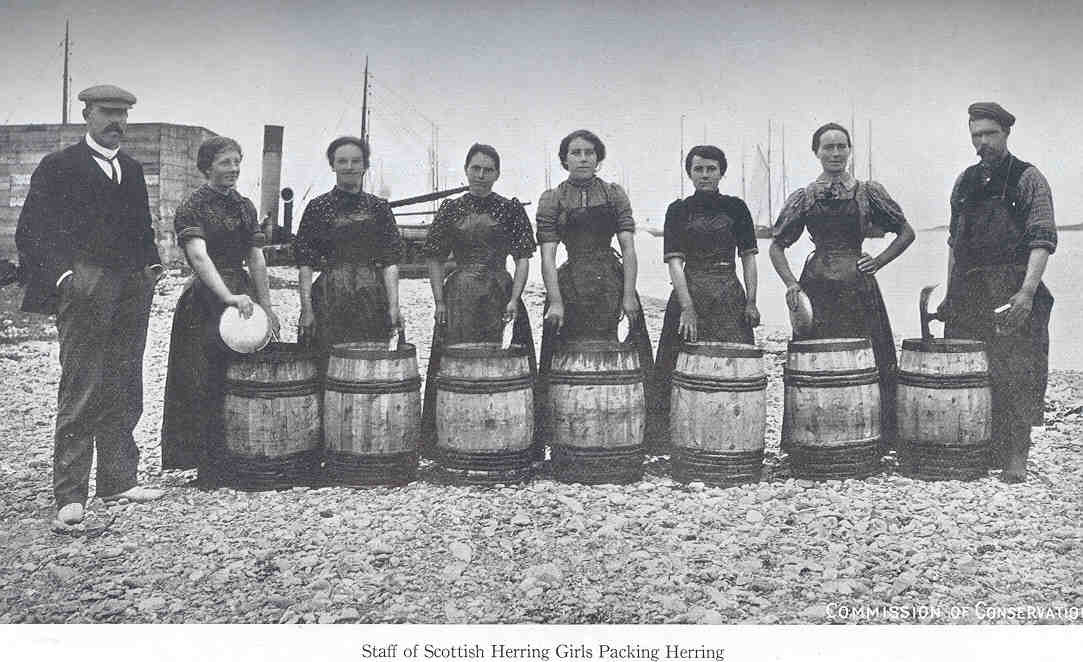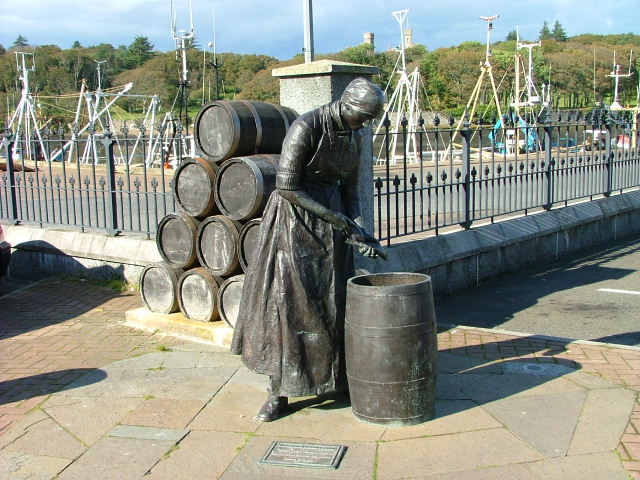Herring girls or herring lassies were the women, some as young as fourteen, who travelled to work on the quaysides of the fishing ports on the east coast of the United Kingdom between Aberdeen and Great Yarmouth, following the herring fleet as it travelled south during the herring season.
Every year vast shoals of herring migrated around Britain, feeding about 30 miles (48 km) off the coast. With the herring came seasonal jobs for fishermen and young women from the Scottish highlands and the Hebrides. For the herring girls, who did the grueling work on the quaysides at the ports where herring was landed, it was a chance to earn money and travel as far south as Yarmouth. They began gutting and packing at the age of fourteen, working in teams of three, two gutting and one packing the fish and salt into wooden barrels. The girls bound their fingers to prevent cuts from the sharp knives they used to gut the fish.
Methods of preservation improved after the Second World War, and the demand for salted herring declined, so that by 1960 the herring girls were no longer required.
Background
Herring have been caught around the British Isles for hundreds of years, and until the Industrial Revolution methods of preserving them had changed little from medieval times. After 1800 the industry expanded greatly when Scottish curers began to pack the freshly caught herring in salt into barrels to standards laid down by the Fishery Board for Scotland. The board set rigorous standards for fish sold under the Crown trademark, making the Scots able to compete with the Dutch, who until then had monopolised the market in northern Europe.[1]
After 1860 the Scots began herring fishing off East Anglia for part of the year, boosting the industry in England, particularly in Great Yarmouth and Lowestoft.[1] Herring are found in commercial quantities in different places, relatively close to land round the coast at different times of year. The fish could be landed in hours, gutted salted and packed in barrels for sale. The fleet followed the fish as the shoals migrated around the coast.[2] Herring ports were found all round Scotland, the Orkneys, Shetland and the east coast of England. The season began in Orkney in May, north-east Scotland in June, Eyemouth in July, north-east England in August and East Anglia from October to December.[3]
Herring lassies
In traditional fishing communities women assisted by mending nets and gutting fish, and even carrying their menfolk on their shoulders out to sea to their boats to keep them dry. In Victorian times, young women from the Hebrides walked across Scotland to work the herring season, living in huts or bothies in ports such as Wick to be paid off before heading home when the season finished. By the 1870s the Scottish fleet was working on the east coast of England, and the curers brought experienced workers from their home ports to North Sheilds, Scarborouch and East Anglia.[4]
In 1913 the industry was no longer local; during the “boom”, more than 10,000 Scottish boats were following the herring along the coast. The boats were accompanied by the herring lassies from the fishing communities, who then worked on the quaysides at the ports where herring was landed.[5] Most herring girls were young and unmarried, mostly from Scotland but a few from Ireland, where the only other jobs for women were in domestic service. Gutting fish was hard and unpleasant work done in the open air, but the wages were better than those of housemaids. Girls started at the age of 14, as had their mothers and other family members.[6]
Recruitment
Curing companies sent agents to the fishing villages around Scotland and the islands to recruit crews of three, two gutters and one packer, to sign up for the herring season. When payment was agreed, all the members of the crew were paid arles,[a]from the Gaelic a earlais an engagement fee, usually ten shillings,[b]50p committing them to stay with the curer until the end of the season. The girls each filled a kist[c]large wooden trunk usually made locally by a carpenter with everything they would need for the ten-week season.[6]
The curers arranged all the ferry and train tickets and accommodation for the crews. Special trains were chartered for girls travelling to Yarmouth and Lowestoft. The curers also employed males who worked as coopers[d]barrel makers and labourers who also travelled to the fishing ports. The men loaded the kists into luggage vans, and the special trains, with up to 300 passengers, left the Kyle of Lochalsh, Oban, Mallaig, Aberdeen and Fraserburgh for a 15-hour overnight journey to East Anglia. At the start of the herring season up to twenty special trains arrived in Yarmouth in one week. When the trains arrived and the kists were unloaded, the young women were transported in the curers’ lorries to pre-arranged digs. Accommodation was in the small terraced houses in the town, in which three girls shared a room and often a bed. Their hosts usually stripped the room of carpets, because the smell of fish lingered long after the girls had left.[7]
Work
The crews were paid by piece work, for full barrels. The faster the team worked the more wages they received. They worked six long days, and had Sundays off.[8]
On the quayside, the catches were landed and spread into a fàrlain, a long, deep, trough around which the gutters worked. Before starting work they wound rags, made from washed flour sacks, around their fingers to protect them from their short sharp knives. While working at speed they were prone to cuts as they slit the fish and the salt that was spread on the herring to help them grasp the slippery fish resulted in painful wounds. The girls threw the cleaned herring into creels. The packers layered the gutted fish into the barrels, each layer covered with rough salt. Coopers used a gauge to measure fish samples so that the barrels were filled up with herring of the same size. The packer’s identification number was branded on every barrel the crew filled.[8]
The barrels were filled three times, after the first filling, the barrel was laid on its side and left to settle. After about ten days the barrel was turned upright and opened. A bung was removed and the salty liquid drained out and saved. More layers of herring were packed in and the saved liquid poured back. A third filling packed the barrel to the brim and it was sealed and branded with the date.[8] A full barrel contained about three hundredweight of fish, between 800 and 1200 depending on size, and a hundredweight of salt.[9] The women worked long days, 12 or 15 hours, until all the catch had been packed into barrels.[10]
Pay, disputes and decline
In the 1920s, in addition to the 10 shillings the women received when they signed up, they were paid about 15 shillings (75p) weekly to cover lodging and food, when the barrels were topped up they received 6d (2 ½p) per hour each, and at the end of the engagement, the crew received 1 shilling (5p) for every barrel filled.[e]to be divided between the three members Pay varied according to the experience and speed at which the crews worked and whether the catches had been good.[11]
Neary 11,000 women in Scotand relied on the industry to make a living in 1912.[12] The following year, 7000 women travelled to work in East Anglia, in 1931 the figure was more than 5000 and more than 6000 in 1939.[13]
In the depression of the 1930s the curers attempted to cut the price per barrel paid to the women. A strike took place in Yarmouth in 1936 and the women succeeded in resisting the cut.[14] The women went on strike again in 1938, when they objected to Sunday-caught herring and demanded improved living allowances.[15]
The industry declined dramatically in the Second Word War. Many fishing vessels were requisitioned by the Admiralty. After the war the boats went back to work and markets revived. Methods of preserving improved, and demand for salted herring declined. By 1960 the herring girls were no longer needed.[16]



